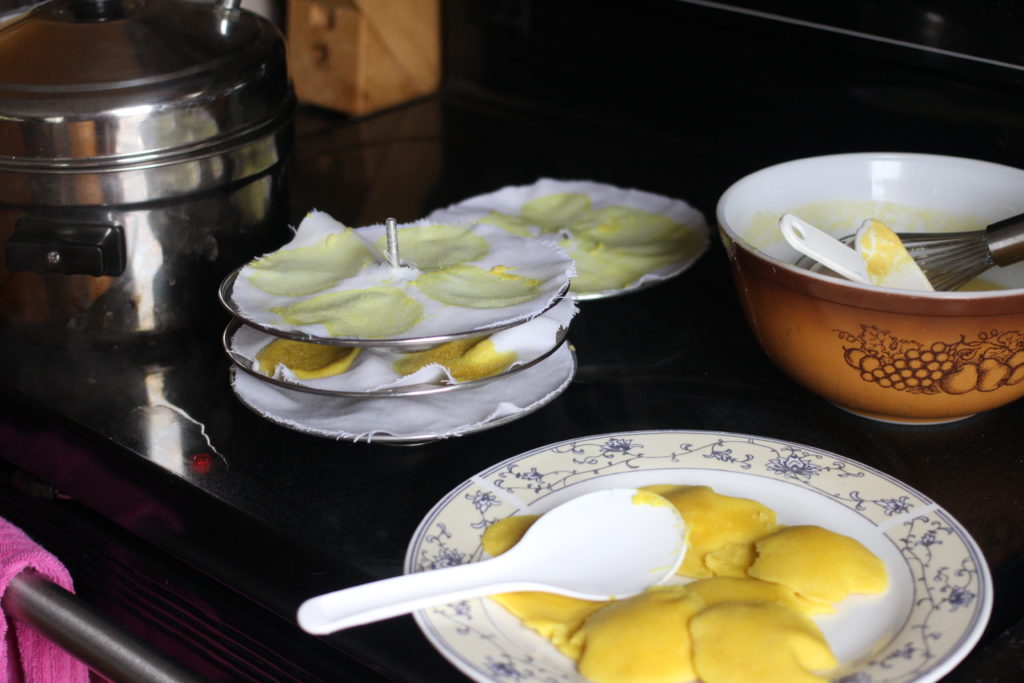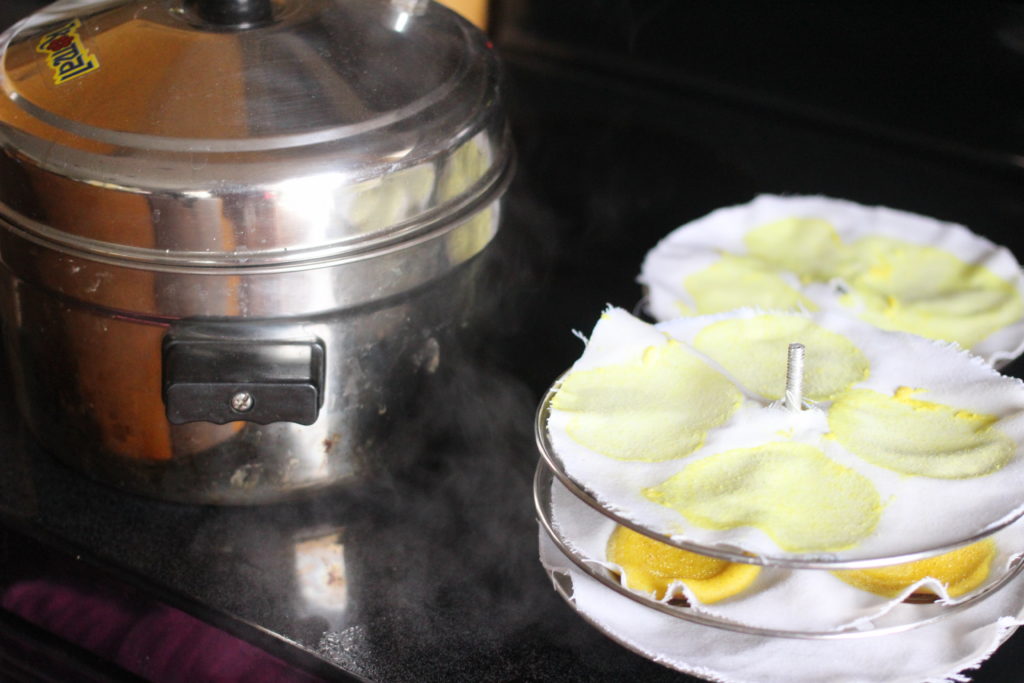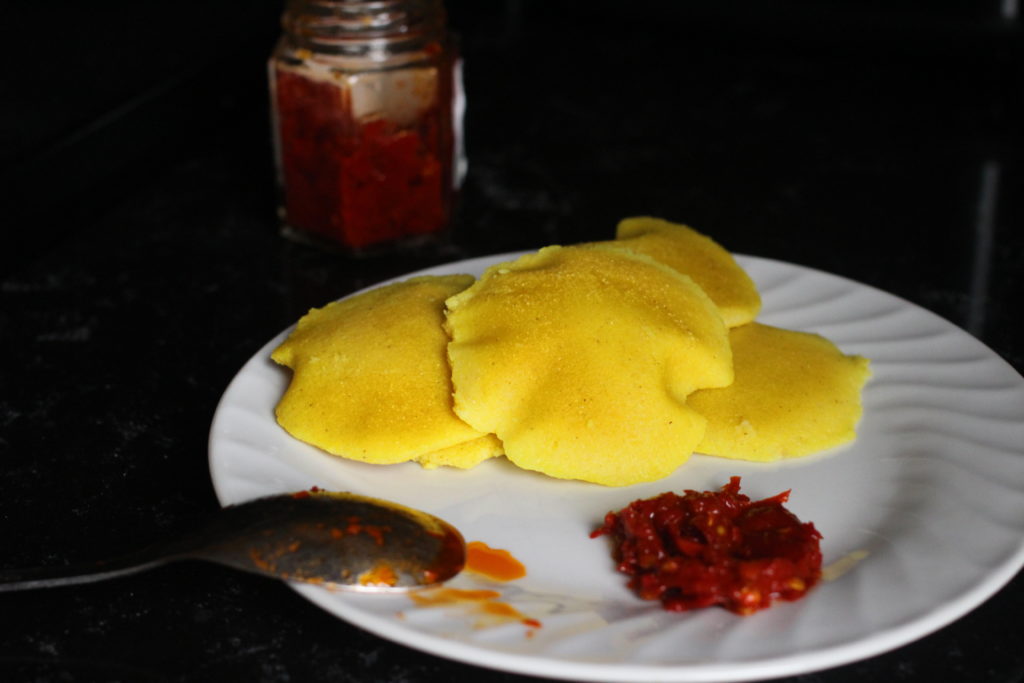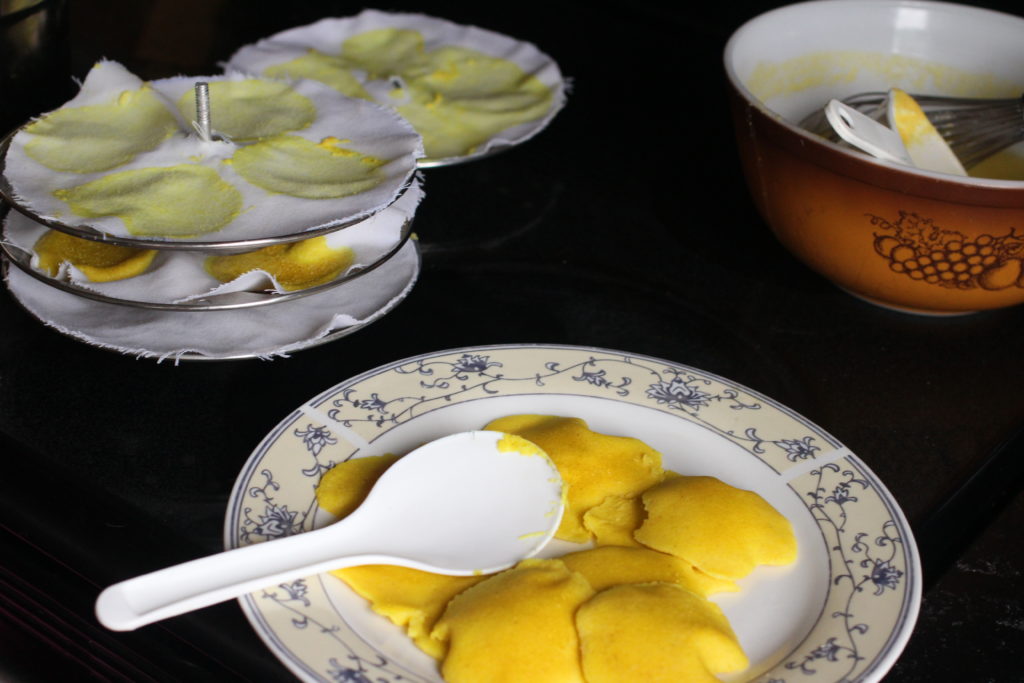
As I remove item after item from my reusable shopping bag to fit the idli steamer inside, I wonder if Nantha Kumar really knows what he’s getting himself into.
The kind chef and Malaysian cooking class instructor has offered to lend me his idli steamer, because the things are dirt cheap in India and crazy expensive here, which makes penny-pinching me snub my nose at the idea of being ripped off by some eBay seller.
Why am I offering him some artisanal balsam fir jam in exchange for an indefinite loan of a metal contraption that’s far less elegant and far more clunky than an Asian dumpling steamer but essentially does the same thing? Because idli are special. The traditional South Indian breakfast food is a steamed rice and lentil cake in the form of a small UFO – fatter in the middle and thinner on the top and bottom. Because the fermented batter is supposed to rise a little as it steams. Sure, you could just spread out the dough and get one giant pancake, but that’s called dosa. The batter is usually the same (fermented rice, lentils and a little salt), except thicker for idli.
After a month of searching for a decently priced, well-reviewed and available to ship to Canada idli steamer, I gave up. Mostly they were cheap factory-made things with lids that didn’t fit properly, stems linking the multiple layers of steamer inserts that broke, and bases that wobbled as they cooked. Don’t even get me started on the mini idli steamers (think timbits instead of doughnuts).
So when Nantha offered me his idli steamer, I jumped at the chance. “I only use it about twice a year,” he said. “I even have some fermented batter leftover that you can have.”
We might have been inebriated. There might have been a piñata involved.
Whatever. An offer is an offer. The least I could do was give the man some jam.
And then I stained his idli steamer cloths yellow from turmeric. Some friend I am. Turns out there are these square cloths that you place on each of the three or four steamer racks so the batter doesn’t drip down into the water below. Air can pass through the cloth, so the idli steam gently while you make your sambhar or chutney or whatever you’re planning to eat with them. Nantha told me not to use the bottom rack, so I could add more water and the pot wouldn’t burn from all the water evaporating. He also told me to not put the lid on too tightly, since it gets stuck and turns into a pressure cooker (I imagine the metal lid would go flying when the pressure built up too much).
The first time I made idli with Nantha’s steamer, I used his batter, which was perfectly fermented and fairly smooth. It hadn’t gotten too acidic from being left out too long or in too much heat. The second time I made idli, I made them with organic cornflour, because why not? I’ve made dosa before and if you can ferment Basmati and urud dal into idli, why not corn? Actually, why not buckwheat, amaranth, quinoa or other lentils besides urad dal?
All I wanted was some extra anti-inflammatories. That’s turmeric, aka benevolent provider of superfood curcumin. But I forgot how it always stains my cutting board when I use it fresh. So when I added it to the already yellow cornmeal to ferment, I wasn’t thinking about the ramifications. Sorry, Nantha.

The next time I made idli, I used whole buckwheat groats. I toasted them like kasha (Russian buckwheat) and then soaked them overnight before grinding them and fermenting them for another day. No turmeric this time.
Because the thing about idli is they’re not supposed to be delicious on their own. I tell you, that buckwheat was bland. The corn had some natural sweetness, but it’s like rice – on its own, completely plain, it’s not that special. It’s comfort food and simple and easy to eat, and you can add anything to do (and should), but idli by itself isn’t going to make the taste receptors on your tongue or the aroma sensors in your nose dance a jig. (That’s definitely not what whatever it is in your nose that senses smells are called…)
So DO add it to anything. Sambar (a spicy tamarind and chili soup), coconut chutney, mint chutney, red pepper chutney, tomato chutney, coriander chutney. Or try some of my favourites: homemade salty chili paste, Dijon mustard or (my coup de coeur) reduced chicken juices from your next roast chicken (or just buy chicken or veal demi glaze).

And when you buy or borrow your own idli steamer to make these, don’t stain the cloths yellow with turmeric. Just make some dal to go with it if you’re dying for some curcumin.
Here are the three idli recipes I made:
TRADITIONAL LENTIL & RICE IDLI
- 2 cups Basmati rice
- 1 cup urad dal
- 1 tsp salt
- 9 cups water, divided
- Wash the rice and dal in several changes of water, then soak them in 8 cups of water in large bowl or pot for at least 8 hours (overnight is good).
- Drain the rice and dal, rinse them and put them in a blender or food processor. Add up to 1 cup of water to help it blend. Blend for 3 minutes.
- Pour the batter back into the bowl or pot. Cover with a clean kitchen towel and let ferment at room temperature for a day (you can just leave it overnight again).
- When the batter has risen and smells slightly fermented, add the salt. Either make idli right away, or refrigerate this batter for up to a week. Don’t leave it on the counter or it’ll keep fermenting and become overly sour.
- To make the idli, pour an inch or two of water into the idli steamer bottom and bring to a boil with the lid on. On the kitchen counter, place the bottom insert on the insert stem. Don’t fill the insert with batter (it’ll touch the water boiling at the bottom of the steamer once you place it in the pot). Place the second insert and top it with a cloth before pouring idli batter into each hollow half-sphere. Top with the next insert and cloth (rotate the insert so that the bottom of each sphere doesn’t touch the layer below) and repeat with batter. Repeat for top insert.
- Place the stem and inserts in the steamer, cover with the lid and let steam for 9 minutes.
- Remove the hot idli molds from the vessel (wear heat-proof gloves if you can), then use a spoon to help peel them from the cloth. It should come away easily. If not, return the insert to the steamer to steam longer.
- Repeat with more batches of idli.
- Serve with sambar, chutney, etc. Refrigerate any leftover idli and they’ll be just as delicious for the next few days. They reheat well. You can also freeze them.
CORN IDLI
I imagine that you could also make these with fresh corn, cut from the cob, soaked in water and then ground and soaked some more. But this way is quick and easy.
- 3 cups non-GMO cornmeal
- 1/2 tsp salt
- 8 cups water
- Whisk the cornmeal into 8 cups of water in large bowl or pot. Cover with a clean kitchen cloth and leave to ferment for at least 12 hours (overnight is fine).
- Stir and check the fermentation (bubbles should start appearing). Cover again and leave for another day.
- Add the salt and dilute with more water if necessary to make a thick pancake batter. Either make idli right away, or refrigerate this batter for up to a week. Don’t leave it on the counter or it’ll keep fermenting and become overly sour.
- To make the idli, pour an inch or two of water into the idli steamer bottom and bring to a boil with the lid on. On the kitchen counter, place the bottom insert on the insert stem. Don’t fill the insert with batter (it’ll touch the water boiling at the bottom of the steamer once you place it in the pot). Place the second insert and top it with a cloth before pouring idli batter into each hollow half-sphere. Top with the next insert and cloth (rotate the insert so that the bottom of each sphere doesn’t touch the layer below) and repeat with batter. Repeat for top insert.
- Place the stem and inserts in the steamer, cover with the lid and let steam for 9 minutes.
- Remove the hot idli molds from the vessel (wear heat-proof gloves if you can), then use a spoon to help peel them from the cloth. It should come away easily. If not, return the insert to the steamer to steam longer.
- Repeat with more batches of corn idli.
- Serve with sambar, chutney, etc. Refrigerate any leftover idli and they’ll be just as delicious for the next few days. They reheat well. You can also freeze them.
BUCKWHEAT IDLI
To make this with buckwheat flour, follow the recipe above for corn idli.
- 3 cups buckwheat groats
- 3/4 tsp salt
- 9 cups water, divided
- Toast the buckwheat over medium heat in a large pot until aromatic and golden, stirring frequently for about 8 minutes.
- Add 8 cups of water and stir. Remove the pot from the heat and pour into a large bowl. Cover with a clean kitchen cloth and leave to ferment for at least 12 hours (overnight is fine).
- Drain the buckwheat, rinse it and put it in a blender or food processor. Add up to 1 cup of water to help it blend if necessary. Blend for 3 minutes.
- Pour the batter back into the bowl or pot. Cover with a clean kitchen towel and let ferment at room temperature for another day.
- The next day, add the salt.
- Stir and check the fermentation (bubbles should start appearing). Cover again and leave for another day.
- Add the salt and dilute with more water if necessary to make a thick pancake batter. Either make idli right away, or refrigerate this batter for up to a week. Don’t leave it on the counter or it’ll keep fermenting and become overly sour.
- To make the idli, pour an inch or two of water into the idli steamer bottom and bring to a boil with the lid on. On the kitchen counter, place the bottom insert on the insert stem. Don’t fill the insert with batter (it’ll touch the water boiling at the bottom of the steamer once you place it in the pot). Place the second insert and top it with a cloth before pouring idli batter into each hollow half-sphere. Top with the next insert and cloth (rotate the insert so that the bottom of each sphere doesn’t touch the layer below) and repeat with batter. Repeat for top insert.
- Place the stem and inserts in the steamer, cover with the lid and let steam for 9 minutes.
- Remove the hot idli molds from the vessel (wear heat-proof gloves if you can), then use a spoon to help peel them from the cloth. It should come away easily. If not, return the insert to the steamer to steam longer.
- Repeat with more batches of buckwheat idli.
- Serve with sambar, chutney, etc. Refrigerate any leftover idli and they’ll be just as delicious for the next few days. They reheat well. You can also freeze them.

Leave a Reply